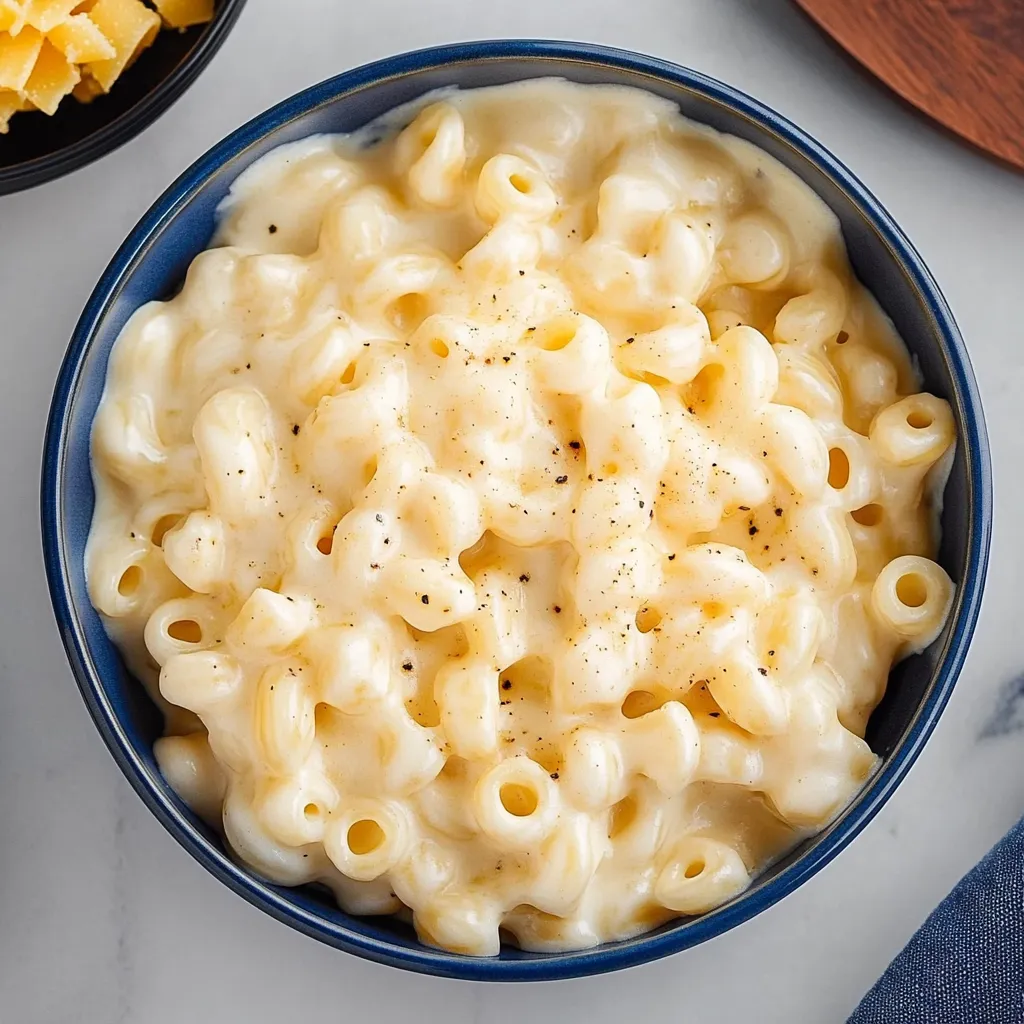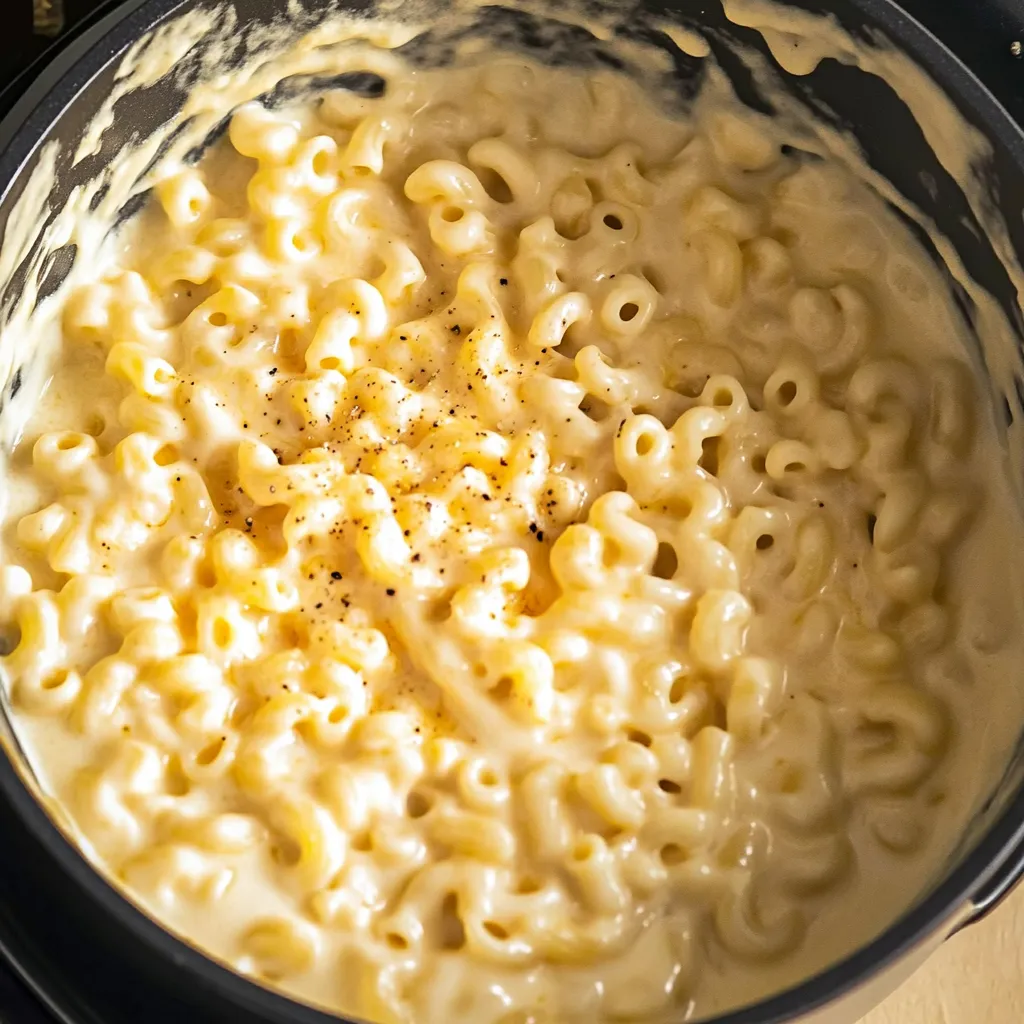 Pin it
Pin it
The ultimate comfort food gets a gourmet upgrade in this spot-on copycat Panera mac and cheese recipe that rivals the restaurant original. Rich, velvety cheese sauce clings to every curve of pasta in this indulgent dish that transforms a simple staple into something truly special. With just a handful of quality ingredients and a few simple techniques, you'll create a restaurant-worthy mac and cheese that's perfect as a satisfying main dish or impressive side—no trip to Panera required!
I first attempted this recipe during a snowstorm when I was craving Panera but couldn't leave the house. The first spoonful transported me straight to the restaurant—that same silky, rich sauce and perfect pasta texture. Now my family actually prefers this homemade version to the original, and I love knowing exactly what goes into it!
Ingredients That Make All The Difference
- White cheddar cheese: The key to achieving Panera's signature flavor and appearance. Regular orange cheddar will taste similar but won't give you the same iconic look. Freshly grated cheese melts much better than pre-shredded, which contains anti-caking agents.
- Half & half: Creates the perfect balance of richness and creaminess without being too heavy. The combination of milk and cream gives the sauce its silky texture.
- Cavatappi pasta: These spiral tubes with ridges capture more sauce than smooth pasta shapes, ensuring every bite is perfectly coated with cheesy goodness.
- Mustard powder: A subtle but essential ingredient that enhances the cheese flavor without adding a distinct mustard taste. This secret ingredient brings depth to the sauce.
- Salted butter: Forms the foundation of the roux that thickens the sauce. Using salted butter adds another layer of flavor from the beginning.
Step-by-Step Instructions
- Begin by bringing a large pot of generously salted water:
- to a rolling boil. The water should taste like the sea—this is your only opportunity to season the pasta itself. Add your cavatappi pasta and cook according to package instructions, but aim for al dente (about 1 minute less than the recommended time). The pasta will continue cooking slightly when combined with the hot cheese sauce, so slightly undercooking it now prevents mushiness later.
- While the pasta cooks:
- prepare your cheese sauce. Start by grating the white cheddar cheese by hand using the large holes of a box grater. Pre-shredded cheese contains anti-caking agents that can make your sauce grainy, so freshly grated is worth the extra effort for a smooth, creamy result. Set the grated cheese aside while you prepare the base of the sauce.
- In a medium saucepan or dutch oven:
- melt the salted butter over medium heat until it's completely liquid but not browning. Add the all-purpose flour and whisk continuously for about 1-2 minutes to cook out the raw flour taste. This roux will thicken your sauce and should be a pale golden color and smell slightly nutty when ready.
- Gradually pour in the half & half:
- while whisking constantly to prevent lumps from forming. Continue whisking until the mixture is completely smooth. Add the mustard powder, salt, and freshly cracked black pepper, continuing to whisk as the mixture heats. Bring the sauce to a gentle simmer, where small bubbles begin appearing around the edges of the pan.
- Once the sauce has thickened:
- enough to coat the back of a spoon (about 3-5 minutes of simmering), reduce the heat to low. This is crucial for incorporating the cheese without overheating it, which can cause it to become grainy or separate. The sauce should be smooth and velvety at this stage.
- Add the grated white cheddar cheese:
- in small handfuls, whisking after each addition until completely melted before adding more. This gradual approach ensures a smooth sauce without graininess. Continue until all cheese is incorporated and the sauce is glossy and smooth with no visible cheese pieces.
- Drain the pasta thoroughly:
- in a colander, giving it a gentle shake to remove excess water. Return the drained pasta to its cooking pot or add it directly to the cheese sauce. Gently fold the pasta into the sauce until every piece is evenly coated. The thick sauce should cling to the pasta, creating a luxurious texture.
- Allow the mac and cheese to sit:
- for 2-3 minutes before serving. This brief rest lets the sauce thicken slightly more and adhere better to the pasta. Serve immediately while hot, garnished with a sprinkle of fresh black pepper or additional grated white cheddar if desired.
 Pin it
Pin it
I discovered the importance of using freshly grated cheese after my first attempt resulted in a slightly grainy texture despite following the recipe perfectly. The culprit was pre-shredded cheese in a bag. When I switched to grating my own white cheddar, the difference was remarkable—silky smooth sauce that coated every piece of pasta just like at Panera.
Creative Variations
While the classic version perfectly replicates Panera's signature dish, this recipe provides an excellent base for customization. For a Buffalo chicken version, stir in shredded rotisserie chicken tossed with buffalo sauce. Create a southwest twist by adding black beans, corn, and a dash of cayenne pepper. For an elevated version, fold in lump crab meat and top with buttered breadcrumbs before baking for 10 minutes until golden.
Perfect Pairings
This rich mac and cheese pairs beautifully with contrasting flavors and textures. Serve alongside a crisp green salad with a light vinaigrette to balance the creaminess. For a complete comfort food experience, pair with a cup of tomato soup for dipping. If serving as a side dish, it complements grilled or roasted meats beautifully, especially those with a touch of acidity like BBQ.
Make-Ahead and Storage Tips
Prepare the cheese sauce up to two days ahead and refrigerate separately from the cooked pasta. When ready to serve, reheat the sauce gently with a splash of half & half, then toss with freshly cooked pasta. For leftovers, refrigerate in an airtight container for up to 4 days. When reheating, add a tablespoon of milk or half & half per cup of mac and cheese to restore the creamy texture.
I've come to treasure this recipe not just for its spot-on replication of a restaurant favorite, but for how it elevates a simple comfort food into something special enough for guests while remaining easy enough for weeknights. There's something deeply satisfying about creating a "copycat" dish that many people swear tastes even better than the original—especially when it comes together in less time than it would take to make the trip to Panera and back.
Frequently Asked Questions
- → Can I use regular elbow macaroni instead of cavatappi?
- Yes, you can substitute elbow macaroni or any short pasta shape. Cavatappi is used for its shape that holds sauce well, but other pasta works too.
- → What is half & half and can I substitute it?
- Half & half is equal parts whole milk and heavy cream. You can substitute with a mix of milk and heavy cream, or use all heavy cream for an extra rich sauce.
- → Can I make this ahead of time?
- Yes, you can make it ahead and reheat slowly on the stove or microwave. Add a splash of milk when reheating as the sauce thickens when refrigerated.
- → What kind of white cheddar should I use?
- Use a good quality, medium to sharp white cheddar. Pre-shredded cheese often has anti-caking agents, so shredding your own will give a smoother sauce.
- → Why is my sauce grainy or lumpy?
- This happens when the sauce is overheated or the cheese is added too quickly. Always add cheese off heat or on very low heat, and stir constantly until melted.
